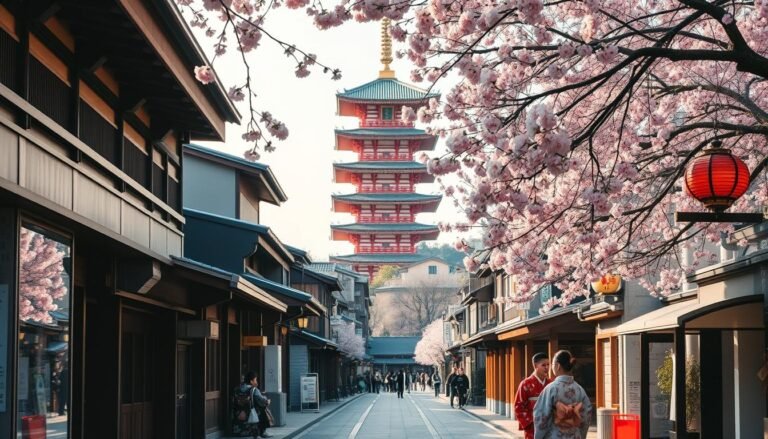
Japan holds tight to a cultural norm that embraces peaceful encounters. Visitors often discover that silence is not mere absence of sound. It is a shared understanding of respect and unity.
Voices may lower on trains, and busy cafes still feel calm. This emphasis on harmony sets the stage for subtle social cues and hidden customs. Travelers who notice these practices will see the nation’s commitment to courtesy in a new light.
Those who seek an authentic experience find that learning about silence can reshape their perspective. It gives a glimpse into centuries of tradition and reveals how each moment is shaped by mindful restraint.
Key Takeaways
- Silence is a silent form of courtesy in Japanese society.
- Noise levels in public are often lower than in other countries.
- Respect for personal space runs through both city and countryside.
- Subtle social rules guide daily greetings and interactions.
- Understanding local customs can strengthen cultural connections.
Understanding the Quiet Culture in Japan
Many visitors notice a calm atmosphere throughout Japanese society. Long-standing norms encourage subtlety in speech, creating a setting where silence can convey respect. In bustling cities like Tokyo or Kyoto, people move with quiet focus that might feel unusual to new travelers.
Historical Roots and Background
Early leadership structures shaped these traditions. Over centuries, teachings that honor elders and promote unity became common. Courteous gestures replaced public confrontations, and silence grew into a marker of thoughtfulness. This approach allowed communities to stay peaceful and avoid clashing opinions.
Group Harmony and Social Expectations
A key concept called wa underscores group harmony. Polite pauses in conversation preserve unity, preventing anyone from feeling singled out. Social interactions often favor listening over speaking. Many travelers find that observing these customs offers insight into Japan’s communal mindset.
Why Silence Is Valued in Japanese Society

Silence holds a special meaning in Japanese society. People remain calm during group discussions to show courtesy and avoid creating conflict. This quiet form of interaction serves as a subtle way to preserve group harmony, letting individuals think before sharing their thoughts. Witnessing someone pause during a conversation can reflect deep respect or genuine openness.
Travelers often find this tranquil approach refreshing. Public areas, such as train platforms or waiting rooms, hold low noise levels that allow for peaceful reflection. Honoring this norm goes beyond words, since restrained gestures also maintain balance in communal settings. Observing this mindset lets visitors adapt smoothly and appreciate the thoughtful aura that surrounds everyday life in Japan.
How Silence Affects Daily Interactions
Quiet moments shape many encounters. A single nod or gentle bow can set a respectful tone, minimizing the need for loud words. This approach fosters calm exchanges, allowing each person to sense the other’s comfort level. Personal space feels preserved, and the overall mood remains considerate.
Greetings and Nonverbal Signals
Soft salutations often replace big hellos. A slight dip of the head may convey more warmth than a long speech. Eye contact tends to be brief, ensuring no one feels overwhelmed. Small gestures like these help newcomers blend into local routines with ease.
| Gesture | Meaning |
|---|---|
| Bow | Respectful greeting |
| Lowered Voice | Thoughtful consideration |
| Minimal Arm Movement | Preserves personal space |
Public Spaces and Commuting Norms
Many prefer to keep phone conversations brief or silent when traveling by train. Passengers value tranquility on crowded routes. Soft whispers are acceptable, but raised voices may invite disapproval. A serene atmosphere often follows, making journeys comfortable for everyone involved.
Japanese Silence Culture, Unspoken Rules in Japan, Quiet Culture in Japan

These three topics reveal a tapestry of etiquette that travelers find unique. Words sometimes carry less weight than a respectful pause, and gentle body language can speak volumes. Eyes on subtle expressions and a calm delivery often leave a deeper impression than overt statements.
Listening with intent helps visitors adapt. Hosts may gauge interest through patient stillness, so a moment of quiet indicates courtesy rather than shyness. A measured response draws people in and builds trust during social gatherings.
Why These Terms Matter for Travelers
These customs shape many social settings from casual chats to formal meals. A visitor who grasps unspoken cues blends more easily with local routines. Trust grows when an uplifting tone and reflective stance guide the conversation.
Navigating Subtlety in Conversation
Travelers flourish by adopting modest volume and observing facial signals. Patience becomes a bridge to understanding shared values. Politeness shines when individuals pause before replying, hinting that every word holds meaning.
| Key Aspect | Travel Benefit |
|---|---|
| Pausing in Dialogue | Shows thoughtfulness and respect |
| Soothing Tonal Delivery | Avoids tension in group discussions |
| Reading Body Language | Encourages deeper cultural connections |
What Tourists Need to Know
Travelers in Japan soon notice how calm surroundings shape daily life. Public spaces feature reserved voices, and personal boundaries matter, even in busy areas. Speaking at a gentle volume can show respect and help avoid awkward moments.
Locals appreciate a warm smile or slight nod instead of grand gestures. Crowds in Tokyo or Kyoto move with quiet rhythm, so blending in often starts with subtle communication. This approach fosters smoother interactions and a relaxed atmosphere for everyone.
Some find it surprising that laughter or chatter on a train may feel intrusive. Eager visitors who mind noise levels and body language tend to make positive impressions. Respectfulness invites friendly responses that can spark lasting memories.
- Keep your voice moderate in restaurants or trains.
- Observe local cues on personal space.
- Avoid large, dramatic gestures.
| Observation | Suggestion |
|---|---|
| Busy Subway Car | Speak softly or remain quiet |
| Crowded Eatery | Use low tones and share space politely |
Tips for Respecting Local Norms

Visiting Japan requires more than enjoying famous landmarks. Observing quiet moments and subtle cues is just as vital. Polite gestures show appreciation for local customs.
Observing Body Language Cues
Polite bows and gentle nods convey deep meaning. A slight tilt of the head or a thoughtful pause may signal agreement or hesitation. Eye contact can be brief, emphasizing harmony rather than confrontation. Noticing these shifts helps travelers adapt in a respectful way.
The Japan National Tourism Organization advises visitors to embrace subtle communication cues, bowing, and respectful speech patterns to create positive experiences.
Choosing Words Carefully
Direct speech is less common in many interactions. A gentle expression such as chotto… signals reluctance without blunt refusal. This approach preserves harmony within social circles. Speaking in a measured tone and acknowledging others with words like sumimasen or arigato highlights sincerity in Japanese culture. When travelers choose words with care, they strengthen respect for local norms and foster deeper connections.
An Anecdote: Silence on Public Transport

Stepping onto a packed Tokyo Metro at dawn can feel like entering a calm bubble. Passengers press together, yet words remain scarce. A student might flip through class notes, and a business professional taps quietly on a smartphone. This silence is a gesture of courtesy toward those nearby.
Visitors from the United States may find this environment surprising. People in some cities use commute time for casual chats. In Japan, trains serve as a shared space that encourages stillness. There is a subtle respect for rest and personal thought, even when body space is limited.
Observing this peaceful routine sparks fresh awareness about local norms. It invites travelers to embrace a different pace. Adapting to the hush on public transport becomes a unique way to bond with Japan’s culture of mindful interaction.
Cultural Context: The Art of Listening in Japan

Quiet observation often takes the spotlight in everyday life. Shared spaces thrive on respectful pauses, inviting each voice to contribute at a measured pace. This approach may feel unusual to visitors seeking quick feedback, yet it reflects a broader commitment to harmony.
It’s a practice that can surprise newcomers who expect constant dialogue. In truth, thoughtful silence can carry as much weight as spoken words, reflecting deep care for everyone’s thoughts.
Schools and Early Socialization
In classrooms, young minds learn to remain attentive without disrupting teachers or classmates. That habit forms a sturdy foundation, showing children how patience can enrich group discussions. Smaller group tasks nurture empathy, and students begin to see how pauses create room for varied perspectives.
Corporate Culture and Meetings
Workplace gatherings often highlight structured listening. Team members might hold back until it’s their turn to present ideas. This format is meant to respect each individual’s input instead of rushing to a conclusion. Observing this style offers newcomers a chance to adapt and foster genuine cooperation.
“Words once spoken cannot be taken back, so weigh them with care.”
Challenges for Western Visitors

Travelers from the United States may sense unease when they first encounter the quiet norms of Japanese culture. Silence at key moments can be a powerful form of communication. This shift toward less verbal expression often poses a hurdle for guests who are used to filling pauses.
Adjusting to Nonverbal Cues
Minor head nods and soft smiles can reveal engagement or agreement. Observing facial expressions and gestures requires patience. A slight pause can signal comfort or respect instead of confusion. Subtle shifts in posture may indicate openness in nonverbal communication.
Avoiding Awkward Misunderstandings
Excess chatter may appear intrusive. Brief silences allow everyone to think before speaking. Tone down direct questions that feel too personal and watch for mild discomfort. Maintaining a balanced exchange can build stronger connections.
| Nonverbal Cue | Meaning |
|---|---|
| Gentle Smile | Polite acknowledgment |
| Short Pause | Time for reflection |
| Nodding | Encouragement to continue |
Nonverbal Communication in Japanese Culture

Many travelers notice how a simple nod or lowered gaze can signal deep respect. Body language often speaks louder than words. Careful attention to another person’s subtle gestures can prevent misunderstandings that disrupt social harmony.
Polite listening stands at the heart of everyday encounters. A gentle bow symbolizes gratitude or humility, and a measured pause invites reflection. Silence in conversation shows thoughtfulness, not disregard. Actions and expressions reveal more than open declarations.
These interactions guide behavior in professional meetings and informal gatherings. Bowing styles vary by context, and eye contact tends to remain brief. Gestures are rarely dramatic, so visitors can learn acceptance by observing local practices.
| Gesture | Implication |
|---|---|
| Deep Bow | Formal greeting or apology |
| Minimal Eye Contact | Courtesy, not aloofness |
| Calm Hand Movements | Respect for personal space |
Silence vs. Communication in Japan
Travelers often notice that conversations in Japan carry a unique rhythm. Some moments pass in quiet reflection, while other times call for a clear response. This subtle blend of speech and pause shapes social harmony and encourages a respectful exchange of ideas.
Balancing Speaking Up and Being Quiet
There is a time to speak and a time to remain still. People may wait for a prompt or invitation before sharing opinions. Voicing thoughts is welcome, yet it works best when balanced with attentive listening. This approach fosters a sense of trust and helps avoid interrupting someone’s personal space.
Cultural Misunderstandings to Avoid
Misreading silence can cause confusion. In some cases, it shows empathy or gives time for reflection. Interrupting that silence may appear intrusive. Staying aware of gestures and facial cues eases interactions and prevents cross-cultural friction.
| Context | Suggested Approach |
|---|---|
| Small Gatherings | Offer your input when asked or when pauses feel natural |
| Group Events | Let others finish their opinions, then share yours calmly |
| One-on-One Chats | Look for subtle eye contact or a direct question before speaking |
Respecting Boundaries in Restaurants
Japan’s dining scene often unfolds in calm and welcoming spots. Many locals prefer low-volume discussions or gentle laughter, ensuring each table keeps a soothing ambiance. A simple nod or a soft sumimasen draws the waitstaff’s attention without disrupting other patrons.
Popular places in Tokyo or Osaka may be bustling, yet conversations remain mindful. An izakaya might have lively chatter, but it rarely reaches the loud buzz found in Western pubs. Savoring each course becomes a quiet ritual that helps everyone enjoy their meal undisturbed.
Showing courtesy at shared tables adds to the overall harmony. Speaking in soft tones and respecting personal space can lead to meaningful connections without straining anyone’s comfort. This approach turns every meal into a peaceful experience, reflecting the deeper culture of listening you’ll find throughout Japan.
How to Practice Mindful Listening as a Tourist
In Japan, noticing subtle cues can create a deeper bond with local communities. A calm presence invites trust, so keep your voice soft and your eyes attentive. Focus on the speaker without interruptions, showing genuine respect for each word. This approach eases any tension and fosters open exchange.
A gentle nod or a single hai indicates you understand the flow of the conversation. Eye contact should be natural, not intense. These small gestures show you prioritize harmony. Repetition of key phrases is optional if you sense the speaker wishes a more active response.
Active Listening Strategies
Try leaning forward slightly when someone shares personal thoughts. Pause before replying to give room for reflection. This method shows you value their perspective.
- Remain calm during group discussions
- Use pauses to absorb information
- Speak in a measured tone to maintain tranquility
Emulating Local Behavior
Visitors who adjust their conduct in busy cities show empathy. Polite acknowledgments such as sō desu ne or wakarimashita communicate your sincere participation. Engage at a level that mirrors the composure around you, particularly in public spaces.
| Approach | Reason |
|---|---|
| Low Volume Speech | Preserves harmony in shared areas |
| Subtle Affirmations | Respects personal boundaries |
Conclusion
Japan’s distinctive blend of calm courtesy and attentive listening shows how silence can carry deep meaning. Unspoken rules in Japan serve as silent bridges that link respect with clear understanding. Glimpses of these customs appear in subtle gestures and respectful pauses.
Quiet culture in Japan is not about withholding thoughts. It is about valuing harmony. Speaking softly in crowded spaces or letting others finish their thoughts brings a sense of balance. These cultural communication norms set a welcoming tone for honest exchange.
Japanese silence culture highlights the power of mindful listening. A brief pause can say more than words when it reflects empathy and openness. That shared silence helps people feel heard, even across language barriers.
The Land of the Rising Sun invites travelers to practice heartfelt awareness. Small acts reveal your willingness to respect local ways. By being present and receptive, you uphold a spirit of unity that transcends spoken language.
FAQs
Q: Why is silence so integral to Japanese society?
A: In Japan, silence is often considered a form of respect and a way to maintain social harmony. This cultural norm is deeply rooted in history and reflects the value placed on listening, minimal disruption, and tacit communication in Japanese culture. Whether you’re on a crowded Tokyo Metro or in a quiet tea house, the emphasis on silence underscores a shared respect for each other’s space.
Q: How does nonverbal communication in Japan work?
A: Nonverbal cues like bowing, gentle nods, or subtle facial expressions are key aspects of social etiquette in Japan. These signals often replace direct verbal expressions and allow people to convey politeness or agreement without speaking loudly. Paying attention to these silent gestures in Japan helps travelers make positive connections.
Q: Am I expected to remain completely silent when using public transit?
A: While you don’t need to be totally silent, be mindful of noise etiquette in Japanese society. Quiet communication—such as hushed tones or texting instead of making phone calls—is appreciated on trains and buses. Observing these social norms in Japan helps maintain the calm environment that locals value.
Q: Is it considered rude to ask questions directly in group settings?
A: Direct questions aren’t necessarily rude, but it’s best to be conscious of timing and tone. Japanese communication style often involves waiting for a natural pause or using polite language. This ensures you’re respecting the group’s comfort, aligning with the tradition of silence in Japan that places emphasis on listening first.
Q: How can I show I’m actively listening without speaking too much?
A: Simple gestures—like nodding, maintaining comfortable eye contact, or offering a polite “hai” (yes)—indicate you’re engaged. This quiet behavior in Japan reflects the art of listening, demonstrating respect for others’ words. Subtle acknowledgments can be more meaningful than lengthy responses.
Q: Do Japanese people ever speak up during disagreements?
A: Absolutely. It’s a misconception that people in Japan never disagree or speak out. However, they often use a softer approach. Maintaining group harmony remains a priority, so they might voice concerns indirectly or wait for a suitable moment. This approach highlights the balance of silence vs. communication in Japan.
Q: What can tourists do to adapt to the quiet culture in Japan?
A: Observing and mirroring local behavior is key. Speak softly in public, be mindful of personal space, and watch for nonverbal cues. Embracing Japanese social norms around silence as a form of respect demonstrates cultural sensitivity. By practicing the power of silence in Japanese society, travelers foster smoother interactions and show genuine courtesy.






